中国组织工程研究 ›› 2026, Vol. 30 ›› Issue (4): 949-963.doi: 10.12307/2026.523
• 组织构建综述 tissue construction review • 上一篇 下一篇
基于双侧肢体控制策略视角分析肢体间不对称对运动能力的影响
金智勇1,汪宇峰2,赵滨杰3,熊敏全4,严 力2
- 哈尔滨体育学院,1研究生院,2体育科学研究院,黑龙江省哈尔滨市 150006;3黑龙江省体育科学研究所,黑龙江省哈尔滨市 150009;4爱丁堡大学,教育与体育学院,苏格兰爱丁堡 EH89YL
-
收稿日期:2024-10-16接受日期:2024-12-19出版日期:2026-02-08发布日期:2025-05-21 -
通讯作者:严力,研究员,博士生导师,哈尔滨体育学院,体育科学研究院,黑龙江哈尔滨 150006 -
作者简介:金智勇,男,1992年生,吉林省延边州人,朝鲜族,哈尔滨体育学院在读博士,主要从事运动生物力学研究。 -
基金资助:国家体育总局科技创新项目(22KJCX064),项目负责人:严力
Effects of inter-limb asymmetry on athletic performance from the perspective of bilateral limb control strategy
Jin Zhiyong1, Wang Yufeng2, Zhao Binjie3, Xiong Minquan4, Yan Li2
- 1Graduate School, 2Institute of Sports Science, Harbin Sport University, Harbin 150006, Heilongjiang Province, China; 3Heilongjiang Research Institute of Sports Science, Harbin 150009, Heilongjiang Province, China; 4Moray House School of Education and Sport, The University of Edinburgh, Edinburgh EH89YL, Scotland, United Kingdom
-
Received:2024-10-16Accepted:2024-12-19Online:2026-02-08Published:2025-05-21 -
Contact:Yan Li, Researcher, Doctoral supervisor, Institute of Sports Science, Harbin Sport University, Harbin 150006, Heilongjiang Province, China -
About author:Jin Zhiyong, PhD candidate, Graduate School, Harbin Sport University, Harbin 150006, Heilongjiang Province, China -
Supported by:National Sports Bureau Science and Technology Innovation Project, No. 22KJCX064 (to YL)
摘要:
文题释义:
肢体间不对称:指对侧肢体在形态结构、功能表现上存在的差异,通常以个体在完成特定任务时肢体间表现差异百分比量化评估不对称程度,其过度发展可能对运动能力、损伤概率造成负面影响。
肢体控制策略:指人体神经系统为有效执行特定运动任务所采用的肢体协调和调控机制,涉及肌肉激活与调节模式,最终实现精确动作控制。动作模式为其在实际运动中的具体表现形式,如肢体移动轨迹、角度变化等。
背景:肢体间不对称是人类生长发育过程中的一般现象,长期专项训练可使运动员肢体间不对称发生特异性适应。
目的:回顾了体育运动中肢体间不对称的形成原因、表现形式及对运动能力的影响,并概述了相关评估方法及干预策略。
方法:检索中国知网、万方、PubMed及Web of Science数据库建库至2024年9月间收录的文献,中文检索词为“不对称,对称,失衡,平衡,力量,爆发力,跳跃,跑,人体测量学,运动损伤,运动能力,运动表现”,英文检索词为“asymmetry,asymmetries,asymmetric,asymmetrical,imbalance,strength,power,force,jump,sprint,athletic performance,anthropometry,injury”。排除重复发表、内容不相关及会议文献后,最终纳入131篇文献进行分析。
结果与结论:①肢体间不对称可受遗传、任务、训练、损伤、疲劳和肢体偏好等因素影响,主要表现为解剖结构、力量表现、专项任务不对称等形式;②肢体间不对称增大可导致双侧同相位对称类运动能力受损,但与双侧异相位对称类运动能力间关系尚不明确;③训练干预可有效改善肢体间不对称,且单侧训练效果优于双侧,训练方式和内容选择应符合专项需求;④为进一步厘清肢体间不对称与运动能力间的关系,建议未来研究秉承肢体间不对称的“任务特异性”理念,规范研究设计,选择敏感测试手段与指标,统一计算方式以提供更多的高质量证据,并分类制定不同专项肢体间不对称的预警阈值标准。
https://orcid.org/0009-0001-1146-6899(金智勇)
中国组织工程研究杂志出版内容重点:干细胞;骨髓干细胞;造血干细胞;脂肪干细胞;肿瘤干细胞;胚胎干细胞;脐带脐血干细胞;干细胞诱导;干细胞分化;组织工程
中图分类号:
引用本文
金智勇, 汪宇峰, 赵滨杰, 熊敏全, 严 力. 基于双侧肢体控制策略视角分析肢体间不对称对运动能力的影响[J]. 中国组织工程研究, 2026, 30(4): 949-963.
Jin Zhiyong, Wang Yufeng, Zhao Binjie, Xiong Minquan, Yan Li. Effects of inter-limb asymmetry on athletic performance from the perspective of bilateral limb control strategy[J]. Chinese Journal of Tissue Engineering Research, 2026, 30(4): 949-963.
2.2 肢体间不对称影响因素 受先天遗传因素影响,人类生长发育过程中普遍存在肢体间不对称现象。运动训练、肢体偏好、运动疲劳和运动损伤等后天环境因素也可影响个体肢体间不对称发展(图4)。因此,肢体间不对称具有个体差异性、波动性和专项性特征。此外,运动任务差异也可对肢体间不对称特征造成影响,因此肢体间不对称也具有方向性和任务特异性。
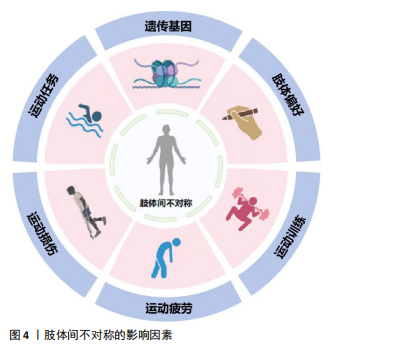
2.2.1 遗传基因 肢体间不对称已在分子生物层面被证明与遗传基因相关,人体双侧肢体发育受不同遗传通路控制。随机噪声(Stochastic noise)可影响相关基因表达,进而导致生物体不对称发展[21]。如MYO1D基因(Pro765Ser)普遍表达于人体多种组织,该基因突变可诱发组织异位异构性发育,导致人体矢状面两侧组织不对称发展[22]。此外,辐射、污染、病毒等环境压力因子(Environmental stressors)也可作为外源性噪声直接或间接作用于生物体,扰乱基因表达稳态进而引发表型变异[23]。人体成熟发育涉及数万亿次细胞分裂,体细胞在复制过程中可积累诱发不对称发展的大量突变。然而,上述变异源同时受Lgr3神经元调控的共同通路所抑制[24],以缓冲、抑制噪声对基因变异的扰动,避免人体非对称性过度发展(图5)。但个体间抑制效果存在差异,并表现出波动性不对称(Fluctuating asymmetry)特征[25]。因此,遗传因素可从解剖、生理、生化等多维度直接影响个体肢体间不对称发展。
理论上,运动者肢体间不对称的解剖和功能差异将最终体现在执行运动任务期间的运动学、动力学等生物力学特征中,影响动作经济性和实效性。实际上人体运动控制是一巨冗余自由度(Degree of freedom)系统,可通过不同协调策略执行相同任务[26]。因此,遗传性肢体
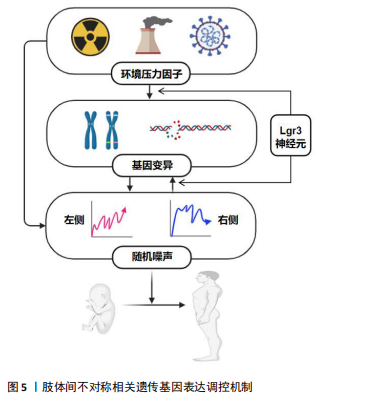
间不对称对运动表现的影响具有较高可塑性,应给予青少年公平的运动参与机会。此外,遗传因素还可放大肢体间不对称对运动损伤的影响,主要体现在:①疼痛敏感性。AMPD1基因缺陷可引起运动后疼痛和肌无力等症
状[27]。运动中优势侧肢体较非优势侧承受更多负荷,但高疼痛阈值运动者可能忽略优势侧肢体的轻微损伤继续训练,增加损伤风险。②损伤易感性。MCCABE等[28]的研究表明,GDF5基因的TT基因型可能与足球运动员踝、膝关节损伤概率增加有关。考虑到肢体间不对称增大可能导致优势侧肢体损伤风险增加,筛查损伤相关高危基因有一定预防价值。③恢复需求。AMPD1基因与高强度、大运动量后的机体恢复速度相关[27]。恢复时间不充分可能导致优势侧肢体的疲劳积累。④肌肉物理特性。骨骼肌具有弹性、伸展性和粘滞性等物理特性,肌联蛋白(Titin,由TTN基因编码)主要在心肌和骨骼肌中表达,能够影响肌肉物理性质[29]。部分需要高柔韧性的任务动作需注意ROM不对称对运动损伤的潜在影响。因此,尽管遗传因素导致肢体间不对称对运动能力的影响较小,但仍可应用于损伤风险/易感性筛查评估。
2.2.2 肢体偏好 遗传因素除可直接影响肢体间不对称表征外,也可通过肢体偏好(Laterality)一定程度间接影响肢体间不对称发展。肢体偏好指个体在执行特定运动任务时表现出对某一侧肢体的优先选择[30],如多数人习惯以右手写字、进餐等。MEDLAND等[31]的研究表明遗传因素可解释人类惯用手选择变异的24%,因此肢体偏好亦受文化、教育等后天环境影响。一项基于大样本量(n=662)的横断面研究表明常人惯用手握力显著高于非惯用手(P < 0.05)[32],肢体偏好被认为是普通人群肢体间不对称形成的主要原因。此外,肢体偏好也可显著影响运动者肢体间不对称特征。“姿势起源理论(Postural origins theory)”认为运动者在学习新运动技能时可能优先选择惯用侧肢体执行核心运动任务[30],如羽毛球运动员以惯用手持拍,足球运动员以惯用脚射门等,并在后续训练过程中促进肢体间不对称进一步发展。然而,运动者在执行不同运动任务时所表现优势侧可能并非其惯用侧肢体[33],提示在评估肢体间不对称对运动能力的影响时应区分惯用侧与优势侧概念。由于肢体间不对称具有任务特异性,建议采用优势/非优势侧概念评估执行不同运动任务中的肢体间不对称。
2.2.3 运动训练 在肢体偏好因素的基础上,长期专项训练是导致运动者肢体间不对称过度发展的主要原因[34]。乒乓球运动者需在专项训练中多次重复双侧非对称类运动,长期训练可使优势侧肢体产生相应结构或功能性适应,导致肢体间不对称升高[35],且肢体间不对称升高幅度与训练频率增加有关[36]。然而,对于短跑等项目而言,因其技术动作具有典型双侧对称性,且训练形式多为双侧或对称类单侧动作,故即使该类项目运动者存在一定程度肢体间不对称,但仍低于一般人群[4]。因此,肢体间不对称具有专项性特征,单侧非对称类项目运动者为满足专项需求,肢体间不对称可呈适应性增大,而双侧对称类项目运动者肢体间不对称相对较小。尽管如此,双侧对称类项目运动者的不良运动姿势、动作模式也可能导致肢体间不对称增加。此外,即使双侧肢体在卧推、深蹲等双侧对称性动作中表现出对称的外部运动学特征,但肌力失衡仍可引发肌肉代偿现象[35],导致双侧肢体各肌群激活程度及协调模式差异,长期训练可致肢体间部分肌群结构、性能不对称程度增加。因此,应定期监测、评估运动者动作模式及相关肌群功能,以避免肢体间不对称过度发展影响运动能力,降低双侧肢体承受负荷不对称导致的运动损伤发生概率。
2.2.4 运动疲劳 肢体间不对称不仅体现于长期运动训练的适应结果,也可于训练过程随疲劳进展变化。运动疲劳可影响机体神经肌肉控制模式,降低肌肉激活水平或改变肌肉激活模式[37]。疲劳导致的神经肌肉控制、本体感觉、姿势控制或运动协调策略等变化可能会影响运动任务执行参数,进而导致肢体间不对称水平改变[38]。RADZAK等[39]的研究也表明男性跑者疲劳后下肢刚度、冲击负荷率不对称程度下降(P < 0.05)。然而,GIRARD等[40]报道了矛盾结果,疲劳后肢体间不对称未发生显著变化,可能与疲劳诱导方案有关。GIRARD等[40]所采用高强度间歇运动所诱导疲劳主要由能源物质耗竭引发,由于该方案运动时间较短(5 s),25 s间歇期内能源物质恢复相对充分,可能无法充分诱导机体疲劳,导致阴性结果。此外,BROMLEY等[41]报告了90 min足球比赛前后运动者[(17.6±0.5)岁]反向跳冲量、峰值力肢体间不对称加剧(P < 0.05)。该研究所采用反向跳测试要求受试者自选下蹲深度跳跃,导致任务执行期间离心、向心冲量等变量95%置信区间ICC下限低至0.29,重测信度低,因此结果仍应慎重解读。除上述因素外,研究间受试者性别、年龄、结局指标类型等差异均可对结果造成影响,因此尚无法明确运动疲劳与肢体间不对称间关系。尽管如此,考虑到机体在运动期间优先依靠优势侧肢体执行核心任务[42],优势侧肢体也将承受更多的负荷压力[43],因此肢体间运动能力差异可能会随疲劳发展降低。VIAL等[42]认为由于肢体间不对称随疲劳发展降低,因此肢体间不对称因素对运动能力的影响也随之削弱。提示疲劳状态可能无法反映运动者真实肢体间不对称,建议在比较肢体间不对称与运动能力间关联时应基于非疲劳状态检测。
2.2.5 运动损伤 急性运动损伤可导致伤肢关节活动度、肌力下降,运动功能受限,出现明显肢体间不对称表征[44]。COLLINGS等[45]报道了有既往前交叉韧带损伤史的足球、橄榄球运动者下肢肌力不对称程度显著高于无损伤史运动者(P < 0.05),重返赛场后下肢力量和跳跃动力学方面持续表现出较大不对称。MESSER等[46]的前瞻性队列研究也表明接受过前交叉韧带重建手术的运动者长期存在较高腘绳肌离心力量不对称,且腘绳肌拉伤概率较无前交叉韧带损伤史群体高2.2倍。提示急性运动损伤所致肢体间不对称可长期存在,需额外关注有既往特定损伤史运动员的肢体间不对称发展,避免重返赛场后的二次损伤。鉴于此,BARBER等[8]建议前交叉韧带术后患者下肢单侧跳跃表现肢体间不对称降至15%以下,并将该阈值作为出院标准。但考虑到高水平运动者对肢体运动功能的更高需求和较长运动暴露时间,KYRITSIS等[47]将该阈值标准进一步降至10%。然而,上述阈值标准效度仍有待商榷。有研究所定义的阈值标准普遍基于跳跃距离、高度,折返跑时间等结果变量建立,但近期研究表明相较于力量发展速率、峰值地面反作用力等运动过程中的性能变量,结果变量对肢体间不对称敏感性相对较低[48]。因此,结果变量肢体间不对称可能低估高水平运动者损伤阈值,基于高敏感度性能变量建立的肢体间不对称损伤阈值更适用于高水平运动者,满足高水平竞技需求。
2.2.6 运动任务 除上述影响因素外,由于人体在执行不同运动任务时的肢体协调策略、神经肌肉工作模式存在差异,因此肢体间不对称具有典型任务特异性,导致同一个体在不同运动任务中的肢体间不对称幅度发生变化。BISHOP 等[17]比较了职业女性足球运动员深蹲跳、反向跳和跳深3种跳跃模式间肢体间不对称差异,结果表明深蹲跳起跳阶段向心冲量显著大于反向跳和跳深(P < 0.05),不同运动任务间相同变量肢体间不对称幅度存在差异。此外,即使在同一任务中,不同变量间肢体间不对称幅度也可能存在差异[49],因此以往针对特定运动任务制定的肢体间不对称阈值可能不具有普适性。
除幅度差异外,肢体间不对称任务特异性也表现为在不同运动任务中的方向变化。DOS’SANTOS等[50]比较了男性团队项目运动者(n=20)等长大腿中段拉期间下肢力-时间特征和505变向(Change of direction)测试肢体间不对称方向对应关系,结果仅1名运动者在等长大腿中段拉和505变向测试中表现出了同侧优势。因此,受不同任务间肢体协调策略、神经肌肉工作模式差异影响,肢体间不对称具有任务特异性,主要表现为执行不同运动任务期间的肢体间不对称幅度和方向差异,肢体间不对称评估过程应注意采用运动形式、动作模式相似任务,避免肢体间不对称评估偏差。
综上,肢体间不对称主要受遗传基因、肢体偏好、运动训练、运动疲劳、运动损伤和运动任务等因素影响。遗传基因可通过分子生物机制诱发肢体解剖与功能不对称发育,因此肢体间不对称可呈波动性发展且具有个体差异性,但一般认为遗传因素导致肢体间不对称不影响运动能力。后天环境因素是导致肢体间不对称过度发展的主要原因,肢体偏好由遗传和后天环境共同作用,机体优先选择惯用侧肢体习得运动技能,并经长期专项训练促进肢体间不对称增大。运动疲劳可改变机体神经肌肉控制模式,机体优先以优势侧执行核心运动任务,因此一般认为肢体间不对称随疲劳发展减小,其对运动能力影响相应降低。运动损伤可导致明显肢体间不对称表征并可长期存在,运动者康复后重返赛场应注意二次损伤风险。不同运动任务的神经肌肉控制模式、肢体协调策略差异,任务间肢体间不对称幅度、方向可发生相应改变,因此肢体间不对称具有任务特异性。建议肢体间不对称评估、干预综合考虑上述因素,以更好地优化运动能力并预防损伤。
2.3 肢体间不对称对运动能力的影响 肢体间不对称已被证明能够对多种运动能力产生影响,为明确二者间关系,以往研究在分析时对运动能力类型进行了划分。BISHOP等[13]从力量、冲刺跑、跳跃、平衡、变向以及特定运动项目表现等角度分析了肢体间不对称与运动能力间关系。MALONEY[4]在其研究中将运动能力归纳为了力量、冲刺跑、跳跃、变向、骑行和其他运动表现等类型。程正义等[14]则分类论述了下肢功能不对称对跳跃、短跑以及变向类运动能力的影响。上述各类运动能力划分在分析其与肢体间不对称关系中可能缺乏一定内在逻辑。肢体间不对称泛指对侧肢体在形态结构、功能表现上存在的差异[13],而功能取决于结构,结构优化可最终体现于神经肌肉控制优化的功能改善[15],基于人体运动控制理论的运动能力类型划分有助于进一步明晰其与肢体间不对称间相互作用。MALONEY[4]主张的动作划分模式为此提供了一定启示,该模式基于GUIARD[51]的人体双手运动协调控制策略理论提出,将体育运动中的动作划分为:①单侧运动,如跳远起跳;②双侧同相位对称运动,如赛艇划桨;③双侧异相位对称运动,如短跑;④双侧非对称运动,如高尔夫球挥杆。然而,GUIARD[51]在其研究中不仅考虑了体育技术动作,还囊括了写字、刷牙等人体日常活动动作,并将该类动作纳入至单侧运动范畴。相较于日常活动动作,体育技术动作更为复杂,通常要求人体环节进行较大幅度空间移动,其强度和速度也远高于日常动作,对神经肌肉协调控制能力提出了较高要求[52-53]。此外,Maloney[4]将跳远起跳动作归类于单侧运动也忽视了摆动腿对提高身体重心和增大地面反作用力的影响,因此可认为不存在绝对的单侧运动模式。
综上,为进一步明晰肢体间不对称与运动能力间关系,此文拟基于双侧肢体运动控制模式对运动能力进行划分以阐述肢体间不对称对运动能力的影响(图6),具体包括:①双侧同相位对称类运动能力;②双侧异相位对称类运动能力;③双侧非对称类运动能力。
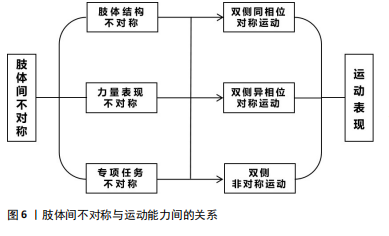
2.3.1 双侧同相位对称类运动能力 双腿跳跃作为足球、篮球、体操等多种运动项目的基本动作,具有典型双侧同相位对称特征。多项研究报道了肢体间不对称能够对反向跳、深蹲跳等双腿跳跃类运动能力产生影响[16,54–56]。BAILEY等[55]评估了下肢等长力量不对称与深蹲跳和反向跳表现间关系,结果表明等长大腿中段拉测试中峰值力不对称幅度与跳跃峰值功率和高度呈显著负相关(r=0.28-0.52,P < 0.05),提示下肢等长力量不对称可损害双腿跳跃能力。为进一步揭示双腿跳跃能力与肢体间不对称的关系,BELL等[16]比较了反向跳期间双侧下肢动力学差异,尽管并未观察到双腿峰值地面反作用力或功率不对称与跳跃高度间的相关性(P > 0.05),但在对不对称程度进行等级划分后,发现肢体间不对称大于10%的群体跳跃表现相对较差(ES > 1.0),且下肢瘦体质量不对称能够解释20%的地面反作用力不对称(R2=0.20,P < 0.01)和25%的峰值功率不对称变异(R2=0.25,P < 0.01)。因此,下肢力量、肌肉质量等肢体间不对称程度过大可能会对双腿跳跃表现造成潜在影响,导致执行双腿跳跃任务期间双侧下肢力量输出肢体间不对称增加,进而降低跳跃能力。
除双腿跳跃外,划桨、举重等任务也具有典型双侧同相位对称运动特征。研究表明运动者执行划桨任务期间,双侧下肢蹬伸力量[57]、桨叶推进力存在不对称现象[20],且降低不对称有助于优化双侧推进效果,提高力量输出效率。此外,在划桨运动过程中也观察到了双侧桨幅、桨速等运动学差异[58]。尽管尚不清楚上述运动学不对称与划桨类(如赛艇)运动能力间的关联,但从能量消耗和推进力效果角度来看,运动者仍可通过降低相应不对称性获益。举重任务方面,ARAUZ等[59]的研究表明相较于低水平运动者,高水平运动者在抓举过程中表现出了更为对称的下肢运动学特征,专项任务肢体间不对称增加可能对举重运动能力造成负面影响。综上,多种形式肢体间不对称增大与双侧对称类运动能力下降有关,肢体间不对称过度发展可导致双侧肢体联合工作效果降低,动力输出效率下降。尽管如此,尚不清楚与该类运动能力下降相关的具体肢体间不对称阈值。
2.3.2 双侧异相位对称类运动能力 前期研究广泛调查了肢体间不对称对双侧异相位对称运动能力的影响,但结果缺乏一致性。冲刺跑具有典型双侧异相位对称运动特征,MADRUGA-PARERA等[60]的研究表明手球运动员20 m冲刺时间与离心飞轮交叉步(Crossover step)测试中峰值向心功率不对称呈正相关(r=0.46,P < 0.05),力量表现肢体间不对称增加可对冲刺跑表现造成负面影响。但也有研究并未观察到短跑运动者反向跳双腿地面反作用力不对称指数与60 m冲刺跑间关联[61]。不同于其他研究采用单脚跳跃测试,该研究中的不对称指数是基于双侧跳跃测试所计算,测试方式差异可对肢体间不对称结果产生影响,且双侧测试肢体间不对称敏感性低于单侧[62],阴性结果可能与此有关。
自行车为典型双侧异相位对称类运动,为分析解剖结构肢体间不对称对它的影响,RAUTER等[63]比较了不同水平自行车运动者间人体测量学差异,结果表明低水平运动者双侧肘围、前臂围、臂表面积、腿部肌肉量、腿长、膝围、小腿围、腿表面积等均存在显著差异(P < 0.01),但在高水平运动者中仅观察到了肘围和前臂围的显著差异(P < 0.01),高水平运动员具有更为对称的下肢解剖结构特征。此外,在该运动中也观察到了专项任务不对称,双侧蹬踏有效力矩(曲柄切向力矩,36%-54%)和合力矩(11%-21%)存在一定程度不对称,且有效力矩不对称与骑行时间呈显著负相关(r=-0.72),即有效力不对称程度越大骑行表现更佳[12]。整体来看,专项任务肢体间不对称增大并未对自行车骑行表现造成负面影响,可能与该项目特殊位移方式有关。冲刺跑、游泳等项目运动者运动过程中肢体直接与位移驱动力(水、地面反作用力)媒介接触,机体双侧交替动力输出不对称增加可能导致身体重心产生较大矢状面或冠状面波动,并改变重心移动轨迹,影响运动表现。然而,自行车运动者需借助外部器械产生位移,器械结构及其与地面间作用方式较为稳定,因此专项任务肢体间不对称增大并未对骑行表现造成负面影响。尽管如此,考虑到加强非优势侧肢体力量能够增加蹬踏总功率输出,减小下肢肢体间不对称仍可能有助于提升骑行表现。
综上,肢体间不对称与双侧异相位对称类运动能力相关研究结果一致性相对较差,结论相悖。矛盾结果可能与多种因素有关:①结局指标敏感性。肢体间不对称具有高度任务特异性,同一个体在不同任务中的肢体间不对称存在差异,应选择敏感任务测试[64]。如冲刺跑能力与下肢拉长-缩短收缩能力高度相关[65],因此相较于深蹲跳,反向跳和跳深对冲刺跑能力更为敏感,相关肢体间不对称更具代表性。②测试方法规范性。部分研究并未明确提供具体测试细节,如跳跃测试中是否允许手臂摆动,以及膝关节起跳角度等,上述因素均可对测试结果造成影响[66-67]。③肢体间不对称评估方式统一性。相关研究分别通过单侧或双侧测试中肢体表现的差异百分比计算肢体间不对称值,且计算方式不同。此外,由于双侧测试可能受“双侧亏损(Bilateral deficit)”或“双侧促进(Bilateral facilitation)”效果影响[68](双侧任务期间总肌力小于或大于单侧任务中同源肌肌力之合),因此单侧测试所得结果能够更好地反映肢体间不对称程度。由于当前研究质量参差不齐,部分研究证据水平和强度等级不足,尚无法定论肢体间不对称与双侧异相位对称类运动能力间关系。然而,考虑到在不降低优势侧肢体工作能力前提下强化非优势侧有助于总输出功率提升,且同等负荷下非优势侧可获得更多训练效益[4],减小肢体间不对称仍对提升双侧异相位对称类运动表现有一定价值。未来研究需进一步规范测试方法和计算方式,并选择敏感指标以进一步揭示二者间关系。
2.3.3 双侧非对称类运动能力 双侧非对称类运动中对侧肢体表现为不同动作模式,如足球踢球,肢体间神经肌肉控制策略差异较大。小球类项目专项技术多为双侧非对称类动作,长期从事该类项目的运动者常表现出肢体间不对称适应性增大[69-70]。研究表明优异棒球运动能力与较大腰腹部肌肉围度、力量肢体间不对称有关,但不对称程度过大可能会增加下背痛发生风险[71]。此外,WOLF等[70]同时报道了乒乓球运动者大脑双侧颞叶皮质活动不对称性显著大于普通人群(P < 0.05),且不对称程度可一定程度预测成绩排名。因此,乒乓球项目运动者所表现的肢体间不对称特征被认为是对长期专项训练的结构和功能性适应,长期重复双侧非对称动作可导致肢体间不对称增加。尽管该现象被认为是对运动需求的良性适应,但肢体间不对称过度发展仍有可能导致损伤风险增加。
快速变向能力对团队项目至关重要,运动者执行快速变向任务期间,需在高强度工作中实现双侧肢体不同运动模式控制。下肢力量是变向能力重要决定因素[72],前期研究广泛调查了力量表现不对称对变向能力的影响,但尚无明确结论[60,62,73],矛盾结果可能与多种因素有关:首先,变向为一复杂任务,除下肢力量素质外,受试者在变向测试中亦可能通过降低重心、调整步幅或减慢入弯速度等策略提高成绩[74];其次,变向测试中直线距离、变向角度、地面材质等差异均可能对测试结果造成影响[75-76],
前期研究间变向测试方案存在差异,可比性相对较差;此外,研究间结局指标敏感性差异也可能导致矛盾结果,相较于跳跃距离或高度等结果变量,输出功率、力量发展速率和下肢刚度等任务执行过程性能变量肢体间不对称敏感性更高,因此结果变量的低肢体间不对称区分度可能导致假阴性结果。鉴于变向能力影响因素纷繁复杂,且研究间变向测试方案和结局指标存在较大差异,目前尚无法确定力量表现不对称与快速变向能力间关系。
综上,肢体间不对称广泛存在于多种运动形式中,可对各类运动能力产生不同程度影响。现有证据表明肢体间不对称增加与双侧同相位对称类运动能力下降有关,肢体间不对称增加可导致双侧肢体联合工作效果降低,破坏动力输出平衡。此外,受肢体间不对称测试方案、计算方法、结局指标敏感性等因素影响,肢体间不对称与双侧异相位对称类运动能力间关系仍不明确。尽管如此,考虑到肢体间不对称减小对增大双侧异相位对称类运动总功率输出的积极影响,降低肢体间不对称可能有助于提升该类运动能力。未来需进一步规范研究设计,统一肢体间不对称的计算方法,选择高肢体间不对称敏感性结局指标以提供更多证据。对于羽毛球、乒乓球挥拍等具有典型双侧非对称特征的运动而言,一般认为肢体间不对称适度增加是对特定任务需求的良性适应,但由于肢体间不对称过大可能使运动者面临更多损伤风险,仍应避免该类项目运动者肢体间不对称过度发展。整体来看,肢体间不对称减小对多数项目有直接或潜在价值,可不同程度提升运动能力或降低损伤概率。然而,尚不清楚各项目运动者运动能力下降具体肢体间不对称的阈值,未来研究可进一步扩大样本量,基于四分位法分类建立金标准。
2.3.4 运动损伤 运动损伤可导致运动表现下降,并为运动者带来额外的心理、经济负担,缩短运动寿命[77]。错误的动作姿势是运动损伤风险因素之一,肢体间不对称一定程度限制了运动者动作控制策略,迫使运动者以低效、功能失调的代偿姿势完成运动任务,触发运动损伤机
制[78]。此外,肢体间不对称可产生单侧肢体依赖性,导致运动过程中优势侧肢体过多承受高强度负荷压力,造成慢性疲劳积累,损伤风险增加。而运动损伤本身也会加剧肢体间不对称程度,进而导致运动损伤复发率增加[47]。
肢体间不对称诱发运动损伤的生物力学机制已基本明确(如在执行变向任务期间双侧膝关节内收、外展力矩,膝关节内旋、屈曲角,骨盆旋转幅度,以及踝关节外旋力矩等差异较大均可诱发前交叉韧带损伤)[79-82],但目前尚无损伤阈值金标准。DANIEL等[6]基于健康人群数据,首次提出将下肢等速肌力不对称小于10%作为前交叉韧带重建患者术后出院标准。考虑到患者日常生活中可能面临更为复杂的下肢任务,BARBER等[8]进一步基于前交叉韧带术后患者多向单侧跳跃和折返跑表现提出了15%的损伤阈值。继该报道后,研究人员试图通过前瞻性研究厘清肢体间不对称与运动损伤风险间关系,但尚无定论。从研究设计来看,研究间测试方案差异较大,测试形式分为单侧和双侧,测试手段包括跑、跳和固定器械等多种形式,且选取指标也呈多样化特征。此外,受试者运动水平不一,对肢体功能需求存在差异,且受专项特征固有影响,运动者间肢体间不对称波动较大[83],因此难以采用统一阈值标准评估不同项目运动者损伤风险。建议未来研究在控制上述实验变量的同时,考虑受试者运动背景、暴露时间等可能对结果产生影响的潜在因素[84],尝试基于不同项目、结局指标分类界定运动损伤肢体间不对称阈值,以进一步揭示肢体间不对称与运动损伤间的规律。
2.4 肢体间不对称评估方法
2.4.1 测试类型 肢体间不对称评估主要包括肢体间不对称测试与计算两部分,其中测试环节涉及多维度参数采集,其信效度直接影响评估结果。从测试类型来看,肢体间不对称测试包括单侧或双侧测试。在双腿跳跃、深蹲等双侧测试中,需采用2台独立设备分别采集单侧数据;而在单腿跳跃、等速肌力测试等单侧测试中,仅需一台设备便可满足数据采集需求,且单侧测试还可通过跳跃高度、距离等结果变量直观体现肢体间不对称程度,可操作性强。因此,相较于双侧测试,单侧测试受实验条件限制较小、操作简便,具有较高的生态效益。此外,人体在执行双侧任务时可受“双侧亏损”或“双侧促进”等协调策略因素影响,故双侧测试可能无法反映真实肢体间差异,单侧测试具有更高的敏感性[85]。然而,对于排球等需完成双侧同相位对称类动作(起跳)的项目,双侧测试仍具有一定的价值,建议该类项目在单侧测试基础上联合双侧测试方式,综合评估运动者执行不同任务期间肢体间不对称特征以满足专项需求。综上,单侧测试肢体间不对称敏感性高且操作相对便利,肢体间不对称评估可优先选择单侧测试,但对于有双侧同相位运动需求的运动者而言,可选择单双侧联合测试方式综合评估运动者肢体间不对称。
2.4.2 测试方法 确定测试类型后,应基于肢体间不对称评估目的合理选择测试方法以提高评估质量。基于肢体间不对称表现形式的相关测试方法介绍有助于系统展示肢体间不对称评估手段,加深理解肢体间不对称表现形式并为针对性干预提供一定依据。根据肢体间不对称表现形式可将测试方法划分为肢体结构、力量表现、专项任务3类。不同测试方法间重测信度、测量效度、肢体间不对称敏感度、操作难度等存在较大差异,方法选择需综合考虑上述因素,肢体间不对称测试方法汇总如表1所示。
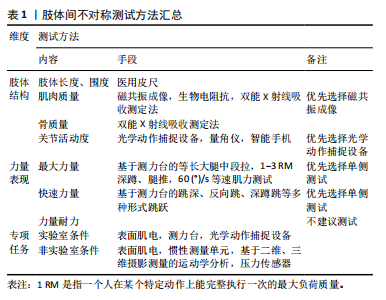
(1)肢体结构:肢体结构肢体间不对称主要涉及对侧肢体长度、围度,关节活动度,以及骨质量以及肌肉质量等差异。肢体长度肢体间不对称评估多采用医用皮尺测量特定骨性关节点间距离,该方法具有较高生态效益和效度,因此被广泛推广[86]。关节活动度评估中,多采用测角仪测量受试者特定体位关节起始与结束位置静态角度差,根据关节解剖特征测试内收/外展、屈/伸、内旋/外旋等多向关节活动度。此外,随着数字技术广泛应用于体育领域,近年来智能手机终端开发的测角相关app也被证明具有良好信效度[87]。但上述测试方法存在一定程度主观性,操作者间重测信度较差,建议全部测量由一名经验丰富的操作者完成。除静态关节活动度外,受试者执行特定任务期间的动态关节活动度也常用于评估肢体功能肢体间不对称,该类评估多采用惯性测量单元(Inertial measurement unit)等便携式传感器或Qualisys等动作捕捉系统测量受试者动态关节活动度[88-89]。上述方法所测运动学参数具有较高信效度且相对客观,因此可作为关节活动度测量金标准。关节位置测量方法同关节活动度,可采用测角仪或运动学测试设备测量静态或动态关节位置。骨质量方面,相关研究多采用双能X射线吸收测定法测量肢体骨密度、骨面积,该方法不受操作者经验影响,且重测信度高(ICC=0.991)[90],因此广泛应用于骨质量肢体间不对称评估。当前肌肉质量测试方法主要包括MRI、双能X射线吸收测定法、生物电阻抗(Bioelectrical bioimpedance)等。其中磁共振成像测试精度最高[91],但该方法实验成本相对较高,因此相关研究多采用双能X射线吸收测定法或生物电阻抗法评估受试者肌肉质量肢体间不对称。此外,部分研究也采用医用皮尺测量肢体围度替代肌肉质量,尽管该方法具有较高生态效益,但易受操作者经验和受试者体脂、运动水平等因素影响[92],因此肢体间不对称结果效度较低。
综上,肢体结构肢体间不对称评估应优先基于高信效度仪器进行,但考虑到生态效益,亦可采用医用皮尺、测角仪、智能手机app等人工测试方法评估关节活动度,肢体围度、长度等肢体间不对称,且测试全程应由同一名经验丰富操作者完成以减少测量误差。
(2)力量表现:力量表现肢体间不对称可呈多种形式,根据力量素质在运动中的外在表现分类,力量表现主要包括最大力量、快速力量以及力量耐力。最大力量肢体间不对称方面,相关研究多采用颈后1-3 RM深蹲或腿推测试评估下肢动态最大力量肢体间不对称[93-94]。腿推测试以单侧测试为主,深蹲测试方式包括单侧和双侧,双侧测试分别采用2个独立测力台评估下肢力量输出肢体间不对称,单侧测试可以最大深蹲重量作为结局指标,但测力台能够基于力量—时间曲线提供更为全面的双侧下肢动力学特征。此外,等速肌力特征也常用于评估下肢动态最大力量[18],主要选取60 (°)/s下峰值力矩/功率评估髋、膝、踝关节等动态最大力量肢体间不对称。除动态力量外,下肢静态最大力量肢体间不对称也被证明与运动表现相关[95],主要采用单/双侧等长大腿中段拉和等速肌力测试仪评估下肢各关节复合、独立最大等长力量肢体间不对称。此外,等速肌力测试也被广泛用于评估上肢各关节动态/静态最大力量肢体间不对称[96]。
快速力量指肌肉快速发挥力量的能力,是力量与速度的有机结合[97],因此多以受试者爆发性任务执行能力评估相关肢体间不对称。深蹲跳、反向跳和跳深等跳跃任务具有典型下肢爆发性和弹道式收缩特征,广泛应用于下肢快速力量肢体间不对称评估。3类跳跃任务均可采用单、双侧测试,鉴于单侧测试的高肢体间不对称敏感性[85],若无特殊需要建议优先选择单侧测试,且执行跳跃任务期间应限制受试者上肢运动,避免协调策略影响测试结果[98]。尽管3类跳跃任务均能够反映下肢快速力量,但相较于深蹲跳,反向跳和跳深更多反映受试者下肢反应力量,两者离心时间不同也导致下肢工作肌拉长-缩短收缩模式存在差异[99],因此应根据专项特征和竞技需要合理选择测试方法。
力量耐力指机体在特定负荷下持续工作,或长时间保持恒定功率输出的能力[100]。从肢体间不对称与运动表现间关系来看,其本质为非对称功能表现导致双侧整体工作效果降低。由于人体在运动中优先使用优势侧肢体执行核心任务,肢体间不对称可随疲劳发展降低,进而弱化肢体间不对称因素对运动表现的影响[42]。因此,研究在比较肢体间不对称与耐力运动能力时多基于运动经济性视角,评估非对称动作模式/动力输出对能量消耗的影响[101]。故一般不将力量耐力肢体间不对称作为评估运动表现的影响因素。
整体来看,前期研究多聚焦于下肢力量表现肢体间不对称,上肢肢体间不对称评估方法和手段相对单一。尽管多数运动项目以下肢动力输出为主导或先导,但在诸如跳跃、冲刺跑等任务中,上肢运动已被证明可通过改善肢体协调策略和增大地面反作用力提升运动表现[98,102],但鲜见相关肢体间不对称报道。未来研究可进一步关注上肢力量表现肢体间不对称与运动能力间关系,借鉴下肢肢体间不对称测试方法和手段评估上肢相关肢体间不对称。此外,基于测力台、等速肌力测试仪所采集力量-时间相关性能变量肢体间不对称敏感性相对较高,力量表现肢体间不对称评估应优先采用该测试方法。若受实验条件限制,也可基于跳跃高度、距离等结果变量进行日常训练肢体间不对称监测。
(3)专项任务:除解剖结构和力量表现外,肢体间不对称也普遍存在于以专项技术为代表的特定专项任务中,前期研究多采用生物力学方法,从运动学、动力学以及肌电特征等角度评估专项任务肢体间不对称。然而,由于体育运动专项技术结构相对复杂,且技术周期内人体环节、重心等可发生较大空间位移,因此多数项目难以采用等速肌力仪或测力台等传统测试方法评估专项任务肢体间不对称,需采用特殊仪器搜集执行专项任务期间生物力学参数。运动学方面,Qualisys和Vicon等光学动作捕捉系统广泛应用于评估受试者任务执行期间双侧肢体角度、速度及位移等差异[103-104]。但受空间、环境限制,部分项目如高山滑雪、游泳等无法在实验室条件下完成,可采用惯性测量单元或Simi Motion收集、分析该类专项任务运动学参数并评估相关肢体间不对称[105-106]。相较于运动学,动力学数据搜集相对复杂,实验室条件下多采用测力台评估双侧下肢综合动力输出差异[107],也可同步运动学数据进行逆动力学计算分析各关节力矩或载荷[108]。对于无法在实验室条件下执行任务,可放置压力传感器于足底、桨柄、踏板等核心动力输出端搜集动力学参数[12,20,109],并结合相关运动学数据分析全身动力学肢体间不对称特征。此外,在运动学和动力学分析基础上,也可同步采集受试者表面肌电(Surface electromyography)信息,结合肌肉激活、协同模式等特征全面评估专项任务肢体间不对称。
综上,肢体结构和力量表现肢体间不对称评估一般可在实验室条件下完成,测试方法相对简单。受专项技术固有动作结构、运动器械、环境等因素影响,专项任务肢体间不对称评估相对复杂。此外,不同于一般生理生化测试,由于肢体间不对称具有任务特异性,部分测试受神经肌肉控制策略影响较大,受试者可能在重复同一任务时表现出较大结果波动。为确保测试信度,建议在力量表现和专项任务肢体间不对称评估中,单项测试重复不低于3次,取平均值进行统计分析[85]。
2.4.3 计算方法 肢体间不对称本质为双侧肢体结构功能差异,为比较其与运动表现、损伤间关联,需在测试获得数据基础上采用公式计算以量化肢体间差异。表2为当前主流肢体间不对称计算公式,不同公式计算肢体间不对称结果存在差异[62]。BISHOP等[62]比较了采用不同公式计算双腿反向跳和单腿反向跳动力学肢体间不对称差异,结果表明在双侧测试种,仅双侧不对称指数1(bilateral asymmetry index,BAI-1)和对称指数2种公式能够客观反映肢体间不对称程度且具有一致性。而在单侧测试中,双侧力量不对称(bilateral strength asymmetry,BSA)或百分数差公式准确性最佳[62]。但对称指数和百分数差公式仅以最高/最低值作为主要变量而未区分优/劣势侧,计算结果可能受伤病、训练或比赛要求等因素影响,因此不宜采用。为确保结果效度,增加研究间可比性,建议未来研究统一采用BAI-1和BSA公式分别计算双侧和单侧测试肢体间不对称。此外,由于肢体间不对称具有方向性,建议计算任务间肢体间不对称 Kappa系数比较肢体间不对称方向一致程度[62],该系数可一定程度反映任务间肢体协调策略和神经肌肉控制差异。
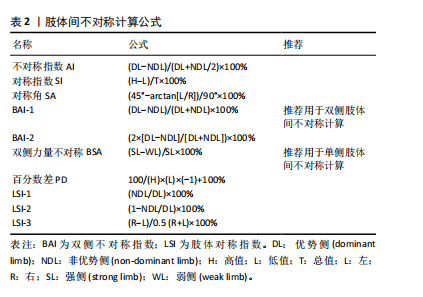
2.5 肢体间不对称干预方式 前期研究广泛调查了训练干预对肢体间不对称的影响,干预类型主要分为单侧和双侧干预,干预内容主要包括等速、离心、增强式训练,功能性训练以及传统抗阻训练等[110-125](表3)。
2.5.1 干预类型 干预类型方面,已有证据表明单侧或双侧训练干预均能够不同程度降低肢体间不对称[111-113]。然而,部分研究并未报道阳性结果。为期6周的双侧腿推干预(5×5)[114],以及8周的10%自重负荷单/双侧下肢复合训练干预均未改善运动者跳跃能力肢体间不对称[117],阴性结果可能与负荷强度(10%自重抗阻训练)、容量(5×5)相对较低有关。同样,MORENO-AZZE等[118]和GONZALO- SKOK等[116]采用1次/周的单、双侧训练干预,8-10周后单腿前、侧跳距离、反向跳高度或180°变向能力等肢体间不对称也未发生显著变化,较低干预频率(1次/周)可能导致了干预效果较弱,未能有效改善肢体间不对称。

为进一步比较单、双侧训练模式干预效果,GONZALO- SKOK等[115]采用随机对照设计分别对两组篮球运动者实施了单侧和双侧训练干预,6周后两组深蹲峰值功率肢体间不对称均有所改善(2.5%-4.8%),但仅单侧组干预前后差异显著(P < 0.05),提示单侧干预效果优于双侧。理论上,运动员在执行双侧同相位对称类任务期间优势侧肢体将承受更多负荷压力[56],因此长期双侧训练可能导致肢体间不对称加剧,但前期证据表明双侧训练仍可改善肢体间不对称,MALONEY[4]的“发展窗口(Development windows)”理论为此现象提供了一定解释(图7):相较于
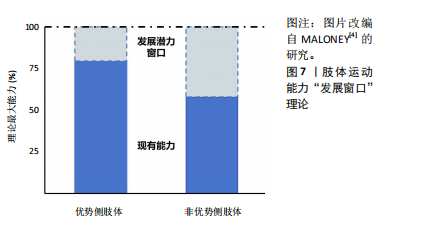
高度发展的优势侧,非优势侧肢体具有更大的负荷适应和发展潜力,非优势侧可从双侧训练中获得更多训练效益,因此双侧训练仍可一定程度减小肢体间形态、功能差异。然而,考虑到相较于双侧训练,单侧训练可为非优势侧肢体提供更多负荷容量,且单侧训练在独立强化弱势侧功能的同时,还可能增加核心对抗旋转、屈伸、侧倾等稳定性需求,为双侧动力输出平衡创造有利条件[126],因此针对肢体间不对称改善可优先选择单侧训练。尽管如此,由于单侧训练可能加重“双侧亏损”效应[127],对于排球等有双侧同相位任务执行需要(双脚起跳)的项目而言,双侧训练仍有一定价值。该类项目可选择联合干预方式,单双侧联合干预方案已被证明可有效降低下肢等速肌力、反向跳跳跃高度等肢体间不对称(P < 0.05)[112-113],减少肢体间不对称的同时改善双侧协调策略,发展“双侧促进”能力。
2.5.2 干预内容 干预内容方面,前期研究表明等速、离心、增强式训练以及传统抗阻训练等均可一定程度改善肢体间不对称[111,114,120],但仍存在部分矛盾结果。MADRUGA- PARERA等[119]对男性青年手球运动者实施了为期8周、2次/周的下肢复合训练干预,训练内容主要包括前、侧弓步,侧蹲,交叉步,以及变向跑和加速跑等,但干预前后前向、侧向跳跃和180°变向跑肢体间不对称无变化,仅反向跳肢体间不对称显著降低(P < 0.05);该研究所采用下肢训练主要基于飞轮(Flywheel)完成,原动肌重复“拉长-缩短”周期收缩模式,神经肌肉特征与反向跳相似,因此仅反向跳肢体间不对称得到改善。同样,ROSO-MOLINER等[122]和MAINER-PARDOS等[123]也未报告10周、每周两三次的神经肌肉干预后跳跃和变向能力肢体间不对称改善。由于上述研究干预方案中训练内容相对复杂,干预部位同时涵盖上、下肢以及躯干核心,干预内容过于泛化,针对性缺失可能是导致阴性结果的主要原因。因此,应根据肢体间不对称改善需求选择针对性训练内容,其动作模式、肌肉收缩形式以及肌拉力线方向等应符合功能适应需求。
2.5.3 训练顺序 除训练类型和内容外,训练顺序也可能对干预效果产生影响。GONZALO-SKOK等[121]对成年男子篮球运动者实施了单侧训练干预,且干预均从弱势侧开始,6周后实验组多向跳跃不对称均显著改善(ES=0.35-0.89,P < 0.05)。作者同时比较了其他同类研究干预效果,认为干预顺序可能是造成研究结果间差异的原因之一,优先执行弱势侧训练对肢体间不对称改善的效果可能更佳。但目前尚无相关随机对照试验证据支持该理论,未来研究可采用随机对照试验设计进一步验证该理论,探讨弱势侧优先训练提高肢体间不对称改善效果机制。
2.5.4 干预时机 此外,长期专项训练已被证明可导致运动者脑组织发生特异性变化,进而影响肢体协调策略和神经肌肉功能[128],因此青少年运动者早期肢体间不对称纠正可能更有利于建立正确的技术动作并预防损伤发生[129]。然而,研究表明运动干预对青春期前、中期运动者肢体间不对称改善效果不佳[120,125],可能与人体肢体间不对称呈波动性发展有关[3]。已有证据表明青少年肢体间不对称发展存在一“触发点”,进入生长速度高峰开始肢体间不对称显著增大[130]。生长速度高峰阶段与多数身体素质发展“敏感期”相对应,ATKINS等[130]认为“敏感期”神经系统非线性成熟,肌肉内、间协同模式改善,解剖结构变化等一系列原因导致了运动控制策略改变,最终造成肢体间不对称增大表征,该假说也得到了一定横断面研究证据支持[130-131]。因此,生长速度高峰结束初期可能是青少年最佳肢体间不对称干预节点。
综上,生长速度高峰结束初期即可实施肢体间不对称干预策略,单、双侧训练干预均可改善肢体间不对称,且单侧效果优于双侧。但双侧训练对发展“双侧促进”效果有积极作用,有双侧同相位任务需求项目可采用单、双侧联合干预模式。训练内容方面,应根据肢体间不对称表现特征选择针对性训练手段,以满足神经肌肉工作模式和肢体协调策略改善需求。此外,为确保干预效果,训练频率不应低于2次/周,且负荷强度、容量需达到一定水平,但具体负荷强度、容量阈值尚不明确。

| [1] ENQUIST M, ARAK A. SYMMETRY, BEAUTY AND EVOLUTION. Nature. 1994;372(6502):169-172. [2] GHIRLANDA S, FRASNELLI E, VALLORTIGARA G. Intraspecific competition and coordination in the evolution of lateralization. Philos Trans R Soc Lond B Biol Sci. 2009;364(1519):861-866. [3] GRAHAM JH, OZENER B. Fluctuating asymmetry of human populations: a review. Symmetry-Basel. 2016;8(12):154. [4] MALONEY SJ. The relationship between asymmetry and athletic performance: a critical review. J Strength Cond Res. 2019;33(9): 2579-2593. [5] BISHOP C, READ P, CHAVDA S, et al. Asymmetries of the lower limb: the calculation conundrum in strength training and conditioning. Strength Cond J. 2016;38(6):27-32. [6] DANIEL D, MALCOLM L, STONE ML. Quantification of knee stability and function. Contemp Orthop. 1982;5(1):83-91. [7] NOYES FR, BARBER SD, MANGINE RE. Abnormal lower limb symmetry determined by function hop tests after anterior cruciate ligament rupture. Am J Sports Med. 1991;19(5):513-518. [8] BARBER SD, NOYES FR, MANGINE RE, et al. Quantitative assessment of functional limitations in normal and anterior cruciate ligament-deficient knees. Clin Orthop. 1990;(255):204-214. [9] PÉREZ-CASTILLA A, GARCÍA-RAMOS A, JANICIJEVIC D, et al. Between-session reliability of performance and asymmetry variables obtained during unilateral and bilateral countermovement jumps in basketball players. PLOS One. 2021;16(7):e0255458. [10] GU CY, LI XR, LAI CT, et al. Sex disparity in bilateral asymmetry of impact forces during height-adjusted drop jumps. Int J Environ Res Public Health. 2021;18(11):5953. [11] LUK HY, WINTER C, O’NEILL E, et al. Comparison of muscle strength imbalance in powerlifters and jumpers. J Strength Cond Res. 2014;28(1):23-27. [12] BINI RR, HUME PA. Relationship between pedal force asymmetry and performance in cycling time trial. J Sports Med Phys Fitness. 2015; 55(9):892-898. [13] BISHOP C, TURNER A, READ P. Effects of inter-limb asymmetries on physical and sports performance: a systematic review. J Sports Sci. 2018;36(10):1135-1144. [14] 程正义,江娟,柴国荣.运动员下肢功能性不对称:回顾、反思与前瞻[J].北京体育大学学报,2023,46(3):132-145. [15] 李丹阳,程序,阙怡琳,等.肢体间不对称对运动表现的影响及干预手段[J].武汉体育学院学报,2021,55(8):94-100. [16] BELL DR, SANFILIPPO JL, BINKLEY N, et al. Lean mass asymmetry influences force and power asymmetry during jumping in collegiate athletes. J Strength Cond Res. 2014;28(4):884-891. [17] BISHOP C, PEREIRA LA, REIS VP, et al. Comparing the magnitude and direction of asymmetry during the squat, countermovement and drop jump tests in elite youth female soccer players. J Sports Sci. 2020;38(11-12):1296-1303. [18] FOUSEKIS K, TSEPIS E, VAGENAS G. Multivariate isokinetic strength asymmetries of the knee and ankle in professional soccer players. J Sports Med Phys Fitness. 2010;50(4):465-474. [19] POULIQUEN C, NICOLAS G, BIDEAU B, et al. Spatiotemporal analysis of 3D kinematic asymmetry in professional cycling during an incremental test to exhaustion. J Sports Sci. 2018;36(19):2155-2163. [20] WARMENHOVEN J, SMITH R, DRAPER C, et al. Force coordination strategies in on-water single sculling: are asymmetries related to better rowing performance? Scand J Med Sci Sports. 2018;28(4):1379-1388. [21] ELOWITZ MB, LEVINE AJ, SIGGIA ED, et al. Stochastic gene expression in a single cell. Science. 2002;297(5584):1183-1186. [22] ALSAFWANI RS, NASSER KK, SHINAWI T, et al. Novel MYO1D missense variant identified through whole exome sequencing and computational biology analysis expands the spectrum of causal genes of laterality defects. Front Med. 2021;8:724826. [23] FRIEDBERG EC. DNA damage and repair. Nature. 2003;421(6921):436-440. [24] VALLEJO DM, JUAREZ-CARREÑO S, BOLIVAR J, et al. A brain circuit that synchronizes growth and maturation revealed through Dilp8 binding to Lgr3. Science. 2015;350(6262):aac6767. [25] ZAKHAROV VM, TROFIMOV IE. Fluctuating asymmetry as an indicator of stress. Emerg Top Life Sci. 2022;6(3):295-301. [26] BERNSTEIN N. The Co-ordination and Regulation of Movements. New York: Pergamon Press, 1967. [27] COLLINS C. Resistance training, recovery and genetics: AMPD1 the gene for recovery. Published online. 2017. [28] MCCABE K, COLLINS C. Can genetics predict sports injury? The association of the genes GDF5, AMPD1, COL5A1 and IGF2 on soccer player injury occurrence. Sports Basel Switz. 2018;6(1):21. [29] MACIEJEWSKA-SKRENDO A, LEŹNICKA K, LEOŃSKA-DUNIEC A, et al. Genetics of muscle stiffness, muscle elasticity and explosive strength. J Hum Kinet. 2020;74:143-159. [30] BOULINGUEZ-AMBROISE G, AYCHET J, POUYDEBAT E. Limb preference in animals: new insights into the evolution of manual laterality in hominids. Symmetry-Basel. 2022;14(1):96. [31] MEDLAND SE, DUFFY DL, WRIGHT MJ, et al. Genetic influences on handedness: data from 25,732 australian and dutch twin families. Neuropsychologia. 2009;47(2):330-337. [32] BARDO A, KIVELL TL, TOWN K, et al. Get a grip: variation in human hand grip strength and implications for human evolution. Symmetry-Basel. 2021;13(7):1142. [33] CARPES FP, MOTA CB, FARIA IE. On the bilateral asymmetry during running and cycling - a review considering leg preference. Phys Ther Sport Off J Assoc Chart Physiother Sports Med. 2010;11(4):136-142. [34] GONZALO-SKOK O, BISHOP C. Change of direction speed and deficit over single and multiple changes of direction: influence of biological age in youth basketball players. J Sports Sci. 2023;41(15):1490-1497. [35] GUIMARÃES AN, UGRINOWITSCH H, DASCAL JB, et al. Freezing degrees of freedom during motor learning: a systematic review. Motor Control. 2020;24(3):457-471. [36] SANCHIS-MOYSI J, DORADO C, OLMEDILLAS H, et al. Bone and lean mass inter-arm asymmetries in young male tennis players depend on training frequency. Eur J Appl Physiol. 2010;110(1):83-90. [37] BARBER-WESTIN SD, NOYES FR. Effect of fatigue protocols on lower limb neuromuscular function and implications for anterior cruciate ligament injury prevention training: a systematic review. Am J Sports Med. 2017;45(14):3388-3396. [38] KNIHS DA, ZIMMERMANN HB, PUPO JD. Acute and delayed effects of fatigue on ground reaction force, lower limb stiffness and coordination asymmetries during a landing task. J Hum Kinet. 2021;76:191-199. [39] RADZAK KN, PUTNAM AM, TAMURA K, et al. Asymmetry between lower limbs during rested and fatigued state running gait in healthy individuals. Gait Posture. 2017;51:268-274. [40] GIRARD O, BROCHERIE F, MORIN JB, et al. Lower limb mechanical asymmetry during repeated treadmill sprints. Hum Mov Sci. 2017;52: 203-214. [41] BROMLEY T, TURNER A, READ P, et al. Effects of a competitive soccer match on jump performance and interlimb asymmetries in elite academy soccer players. J Strength Cond Res. 2021;35(6):1707-1714. [42] VIAL S, COCHRANE WILKIE J, TURNER M, et al. Fatigue does not increase limb asymmetry or induce proximal joint power shift in habitual, multi-speed runners. J Sports Sci. 2023;41(12):1250-1260. [43] KOBAYASHI Y, KUBO J, MATSUO A, et al. Bilateral asymmetry in joint torque during squat exercise performed by long jumpers. J Strength Cond Res. 2010; 24(10):2826-2830. [44] OPAR DA, SERPELL BG. Is there a potential relationship between prior hamstring strain injury and increased risk for future anterior cruciate ligament injury? Arch Phys Med Rehabil. 2014;95(2):401-405. [45] COLLINGS TJ, DIAMOND LE, BARRETT RS, et al. Impact of prior anterior cruciate ligament, hamstring or groin injury on lower limb strength and jump kinetics in elite female footballers. Phys Ther Sport Off J Assoc Chart Physiother Sports Med. 2021;52:297-304. [46] MESSER DJ, WILLIAMS MD, BOURNE MN, et al. Anterior cruciate ligament reconstruction increases the risk of hamstring strain injury across football codes in Australia. Sports Med Auckl NZ. 2022;52(4): 923-932. [47] KYRITSIS P, BAHR R, LANDREAU P, et al. Likelihood of ACL graft rupture: not meeting six clinical discharge criteria before return to sport is associated with a four times greater risk of rupture. Br J Sports Med. 2016;50(15):946-951. [48] KING E, RICHTER C, FRANKLYN-MILLER A, et al. Biomechanical but not timed performance asymmetries persist between limbs 9 months after ACL reconstruction during planned and unplanned change of direction. J Biomech. 2018;81:93-103. [49] BISHOP C, READ P, CHAVDA S, et al. Using unilateral strength, power and reactive strength tests to detect the magnitude and direction of asymmetry: a test-retest design. Sports Basel Switz. 2019;7(3):58. [50] DOSʼSANTOS T, THOMAS C, JONES PA, et al. Asymmetries in isometric force-time characteristics are not detrimental to change of direction speed. J Strength Cond Res. 2018;32(2):520-527. [51] GUIARD Y. Asymmetric division of labor in human skilled bimanual action: the kinematic chain as a model. J Mot Behav. 1987;19(4): 486-517. [52] 杨宗青,米靖,周松芳,等.UCM协同理论控制机制及应用的研究进展[J]. 体育科学,2023,43(5):71-88. [53] GLAZIER PS. Beyond animated skeletons: how can biomechanical feedback be used to enhance sports performance? J Biomech. 2021; 129:110686. [54] 唐桥,张海忠.综合性项目运动员动态平衡能力与双侧膝关节肌力、下肢爆发力的相关性研究[J].中国体育科技,2019,55(5):65-71+80. [55] BAILEY CA, SATO K, BURNETT A, et al. Carry-over of force production symmetry in athletes of differing strength levels. J Strength Cond Res. 2015;29(11):3188-3196. [56] BAZYLER CD, BAILEY CA, CHIANG CY, et al. The effects of strength training on isometric force production symmetry in recreationally trained males. J Trainol. 2014;3(1):6-10. [57] BUCKERIDGE EM, BULL AMJ, MCGREGOR AH. Foot force production and asymmetries in elite rowers. Sports Biomech. 2014;13(1):47-61. [58] 闫家祥,梁志强,但林飞,等.我国男子赛艇双人双桨奥运会奖牌获得者拉桨动作的生物力学分析[J].中国体育科技,2023,59(4):11-18. [59] ARAUZ PG, GARCIA G, LLERENA J. Biomechanical analysis of the snatch technique for elite and varsity weightlifters. J Biomech. 2024;175: 112291. [60] MADRUGA-PARERA M, BISHOP C, BEATO M, et al. Relationship between interlimb asymmetries and speed and change of direction speed in youth handball players. J Strength Cond Res. 2021;35(12):3482-3490. [61] EXELL T, IRWIN G, GITTOES M, et al. Strength and performance asymmetry during maximal velocity sprint running. Scand J Med Sci Sports. 2017;27(11):1273-1282. [62] BISHOP C, READ P, LAKE J, et al. Interlimb asymmetries: understanding how to calculate differences from bilateral and unilateral tests. Strength Cond J. 2018; 40(4):1-6. [63] RAUTER S, SIMENKO J. Morphological asymmetries profile and the difference between low- and high-performing road cyclists using 3D scanning. Biology. 2021;10(11):1199. [64] VIRGILE A, BISHOP C. A narrative review of limb dominance: task specificity and the importance of fitness testing. J Strength Cond Res. 2021;35(3):846-858. [65] RAMÍREZ-CAMPILLO R, ANDRADE DC, IZQUIERDO M. Effects of plyometric training volume and training surface on explosive strength. J Strength Cond Res. 2013;27(10):2714-2722. [66] REITER CR, KILLELEA C, FAHERTY MS, et al. Force-plate derived predictors of lateral jump performance in NCAA division-I men’s basketball players. PLOS One. 2023;18(4):e0284883. [67] MACKALA K, STODÓŁKA J, SIEMIENSKI A, et al. Biomechanical analysis of squat jump and countermovement jump from varying starting positions. J Strength Cond Res. 2013;27(10):2650-2661. [68] ŽELEZNIK P, SLAK V, KOZINC Ž, et al. The association between bilateral deficit and athletic performance: a brief review. Sports Basel Switz. 2022;10(8):112. [69] BRAVO-SÁNCHEZ A, ABIÁN P, JIMÉNEZ F, et al. Myotendinous asymmetries derived from the prolonged practice of badminton in professional players. PLOS One. 2019;14(9):e0222190. [70] WOLF S, BRÖLZ E, KEUNE PM, et al. Motor skill failure or flow-experience? Functional brain asymmetry and brain connectivity in elite and amateur table tennis players. Biol Psychol. 2015;105:95-105. [71] HIDES J, STANTON W, FREKE M, et al. MRI study of the size, symmetry and function of the trunk muscles among elite cricketers with and without low back pain. Br J Sports Med. 2008;42(10):809-813. [72] 杨威,李博,高崇,等.足球运动员变向能力的测试方法、影响因素和训练策略[J].首都体育学院学报,2021,33(5):507-521. [73] BISHOP C, BRASHILL C, ABBOTT W, et al. Jumping asymmetries are associated with speed, change of direction speed, and jump performance in elite academy soccer players. J Strength Cond Res. 2021;35(7):1841-1847. [74] SHEPPARD JM, YOUNG WB. Agility literature review: classifications, training and testing. J Sports Sci. 2006;24(9):919-932. [75] GAINS GL, SWEDENHJELM AN, MAYHEW JL, et al. Comparison of speed and agility performance of college football players on field turf and natural grass. J Strength Cond Res. 2010;24(10):2613-2617. [76] NIMPHIUS S, CALLAGHAN SJ, BEZODIS NE, et al. Change of direction and agility tests: challenging our current measures of performance. Strength Cond J. 2018;40(1):26-38. [77] BAHR R, HOLME I. Risk factors for sports injuries--a methodological approach. Br J Sports Med. 2003;37(5):384-392. [78] MURPHY DF, CONNOLLY DA, BEYNNON BD. Risk factors for lower extremity injury: a review of the literature. Br J Sports Med. 2003; 37(1):13-29. [79] COLLINGS TJ, GORMAN AD, STUELCKEN MC, et al. Exploring the justifications for selecting a drop landing task to assess injury biomechanics: a narrative review and analysis of landings performed by female netball players. Sports Med Auckl NZ. 2019;49(3):385-395. [80] HOWARD JS, FAZIO MA, MATTACOLA CG, et al. Structure, sex, and strength and knee and hip kinematics during landing. J Athl Train. 2011;46(4):376-385. [81] KIM HK, ZHANG Y. Estimation of lumbar spinal loading and trunk muscle forces during asymmetric lifting tasks: application of whole-body musculoskeletal modelling in OpenSim. Ergonomics. 2017;60(4): 563-576. [82] PFEIFFER SJ, BLACKBURN JT, LUC-HARKEY B, et al. Peak knee biomechanics and limb symmetry following unilateral anterior cruciate ligament reconstruction: associations of walking gait and jump-landing outcomes. Clin Biomech Bristol Avon. 2018;53:79-85. [83] KRAWCZYK B, SKLAD M, MAJLE B, et al. Lateral asymmetry in upper and lower limb measurements in selected groups of Male athletes. Biol Sport. 1998;15(1):33-38. [84] GUAN Y, BREDIN SSD, TAUNTON J, et al. Association between inter-limb asymmetries in lower-limb functional performance and sport injury: a systematic review of prospective cohort studies. J Clin Med. 2022;11(2):360. [85] BISHOP C, DE KEIJZER KL, TURNER AN, et al. Measuring interlimb asymmetry for strength and power: a brief review of assessment methods, data analysis, current evidence, and practical recommendations. J Strength Cond Res. 2023;37(3):745-750. [86] MAHAKIZADEH S, GHOROGHI FM, MOSHKDANIAN G, et al. The determination of correlation between stature and upper limb and hand measurements in iranian adults. Forensic Sci Int. 2016;260:27-30. [87] MEHTA SP, BARKER K, BOWMAN B, et al. Reliability, concurrent validity, and minimal detectable change for iPhone goniometer app in assessing knee range of motion. J Knee Surg. 2017;30(6):577-584. [88] BAUER CM, RAST FM, ERNST MJ, et al. Concurrent validity and reliability of a novel wireless inertial measurement system to assess trunk movement. J Electromyogr Kinesiol Off J Int Soc Electrophysiol Kinesiol. 2015;25(5):782-790. [89] CARDOSO TB, OCARINO JM, FAJARDO CC, et al. Hip external rotation stiffness and midfoot passive mechanical resistance are associated with lower limb movement in the frontal and transverse planes during gait. Gait Posture. 2020;76:305-310. [90] HEPPE DHM, TAAL HR, ERNST GDS, et al. Bone age assessment by dual-energy X-ray absorptiometry in children: an alternative for X-ray? Br J Radiol. 2012;85(1010):114-120. [91] MADEN-WILKINSON TM, DEGENS H, JONES DA, et al. Comparison of MRI and DXA to measure muscle size and age-related atrophy in thigh muscles. J Musculoskelet Neuronal Interact. 2013;13(3):320-328. [92] WAGNER DR, HEYWARD VH. Techniques of body composition assessment: a review of laboratory and field methods. Res Q Exerc Sport. 1999;70(2):135-149. [93] MATTES K, WOLLESEN B, MANZER S. Asymmetries of maximum trunk, hand, and leg strength in comparison to volleyball and fitness athletes. J Strength Cond Res. 2018;32(1):57-65. [94] HAMMAMI R, NOBARI H, HANEN W, et al. Exploring of two different equated instability resistance training programs on measure of physical fitness and lower limb asymmetry in pre-pubertal weightlifters. BMC Sports Sci Med Rehabil. 2023;15(1):40. [95] MORENO-PÉREZ V, MÉNDEZ-VILLANUEVA A, SOLER A, et al. No relationship between the nordic hamstring and two different isometric strength tests to assess hamstring muscle strength in professional soccer players. Phys Ther Sport Off J Assoc Chart Physiother Sports Med. 2020;46:97-103. [96] ELLENBECKER TS, ROETERT EP, RIEWALD S. Isokinetic profile of wrist and forearm strength in elite female junior tennis players. Br J Sports Med. 2006;40(5):411-414. [97] 田麦久,刘大庆.运动训练学[M].北京:人民体育出版社,2012. [98] HARMAN EA, ROSENSTEIN MT, FRYKMAN PN, et al. The effects of arms and countermovement on vertical jumping. Med Sci Sports Exerc. 1990;22(6):825-833. [99] THOMAS K, FRENCH D, HAYES PR. The effect of two plyometric training techniques on muscular power and agility in youth soccer players. J Strength Cond Res. 2009;23(1):332-335. [100] NUZZO JL. Narrative review of sex differences in muscle strength, endurance, activation, size, fiber type, and strength training participation rates, preferences, motivations, injuries, and neuromuscular adaptations. J Strength Cond Res. 2023;37(2):494-536. [101] BLAGROVE RC, BISHOP C, HOWATSON G, et al. Inter-limb strength asymmetry in adolescent distance runners: test-retest reliability and relationships with performance and running economy. J Sports Sci. 2021;39(3):312-321. [102] ARAGONVARGAS LF, GROSS MM. Kinesiological factors in vertical jump performance: differences among individuals. J Appl Biomech. 1997;13(1):24-44. [103] PETRELLA M, SELISTRE LFA, SERRÃO PRMS, et al. Kinetics, kinematics, and knee muscle activation during sit to stand transition in unilateral and bilateral knee osteoarthritis. Gait Posture. 2021;86:38-44. [104] WAGNER H, TILP M, VON DUVILLARD SP, et al. Kinematic analysis of volleyball spike jump. Int J Sports Med. 2009;30(10):760-765. [105] CESERACCIU E, SAWACHA Z, FANTOZZI S, et al. Markerless analysis of front crawl swimming. J Biomech. 2011;44(12):2236-2242. [106] OGRIN J, ŠARABON N, MADSEN MK, et al. Asymmetries in ground reaction forces during turns by elite slalom alpine skiers are not related to asymmetries in muscular strength. Front Physiol. 2021;12:577698. [107] 束洋,梁志强,马沐佳,等.我国速度滑冰国家队运动员下肢不对称性的生物力学分析[J].上海体育学院学报,2023,47(6):67-75. [108] PATERNO MV, SCHMITT LC, FORD KR, et al. Biomechanical measures during landing and postural stability predict second anterior cruciate ligament injury after anterior cruciate ligament reconstruction and return to sport. Am J Sports Med. 2010;38(10):1968-1978. [109] THOMSON A, EINARSSON E, HANSEN C, et al. Marked asymmetry in vertical force (but not contact times) during running in ACL reconstructed athletes <9 months post-surgery despite meeting functional criteria for return to sport. J Sci Med Sport. 2018;21(9):890-893. [110] 郝月蓉.单腿复合式训练对男性大学生篮球运动员下肢非对称性的干预效果[D].北京:北京体育大学,2020. [111] 雷正方,张瑛秋.整合性神经肌肉训练对听障乒乓球运动员下肢功能性不对称与平衡能力的影响[J].体育科学,2018,38(11):28-38+97. [112] SANNICANDRO I, COFANO G, ROSA RA, et al. Balance training exercises decrease lower-limb strength asymmetry in young tennis players. J Sports Sci Med. 2014;13(2):397-402. [113] DELLO IACONO A, PADULO J, AYALON M. Core stability training on lower limb balance strength. J Sports Sci. 2016;34(7):671-678. [114] GONZALO-SKOK O, TOUS-FAJARDO J, ARJOL-SERRANO JL, et al. Improvement of repeated-sprint ability and horizontal-jumping performance in elite young basketball players with low-volume repeated-maximal-power training. Int J Sports Physiol Perform. 2016; 11(4):464-473. [115] GONZALO-SKOK O, TOUS-FAJARDO J, SUAREZ-ARRONES L, et al. Single-leg power output and between-limbs imbalances in team-sport players: unilateral versus bilateral combined resistance training. Int J Sports Physiol Perform. 2017;12(1):106-114. [116] GONZALO-SKOK O, MORENO-AZZE A, ARJOL-SERRANO JL, et al. A comparison of 3 different unilateral strength training strategies to enhance jumping performance and decrease interlimb asymmetries in soccer players. Int J Sports Physiol Perform. 2019;14(9):1256-1264. [117] PARDOS-MAINER E, CASAJÚS JA, BISHOP C, et al. Effects of combined strength and power training on physical performance and interlimb asymmetries in adolescent female soccer players. Int J Sports Physiol Perform. 2020;15(8):1147-1155. [118] MORENO-AZZE A, ARJOL-SERRANO JL, FALCÓN-MIGUEL D, et al. Effects of three different combined training interventions on jump, change of direction, power performance, and inter-limb asymmetry in Male youth soccer players. Sports Basel Switz. 2021;9(12):158. [119] MADRUGA-PARERA M, BISHOP C, FORT-VANMEERHAEGHE A, et al. Effects of 8 weeks of isoinertial vs. Cable-resistance training on motor skills performance and interlimb asymmetries. J Strength Cond Res. 2022;36(5):1200-1208. [120] HAMMAMI R, DUNCAN MJ, NEBIGH A, et al. The effects of 6 weeks eccentric training on speed, dynamic balance, muscle strength, power, and lower limb asymmetry in prepubescent weightlifters. J Strength Cond Res. 2022;36(4):955-962. [121] GONZALO-SKOK O, SÁNCHEZ-SABATÉ J, TOUS-FAJARDO J, et al. Effects of direction-specific training interventions on physical performance and inter-limb asymmetries. Int J Environ Res Public Health. 2022; 19(3):1029. [122] ROSO-MOLINER A, MAINER-PARDOS E, CARTÓN-LLORENTE A, et al. Effects of a neuromuscular training program on physical performance and asymmetries in female soccer. Front Physiol. 2023; 14:1171636. [123] MAINER-PARDOS E, VILLAVICENCIO ÁLVAREZ VE, MORENO-APELLANIZ N, et al. Effects of a neuromuscular training program on the performance and inter-limb asymmetries in highly trained junior male tennis players. Heliyon. 2024;10(5):e27081. [124] MORENO-AZZE A, ARJOL-SERRANO JL, FALCÓN-MIGUEL D, et al. Comparison of three eccentric overload training strategies on power output and interlimb asymmetry in youth soccer players. Int J Environ Res Public Health. 2021;18(16):8270. [125] PICHARDO AW, OLIVER JL, HARRISON CB, et al. Effects of combined resistance training and weightlifting on injury risk factors and resistance training skill of adolescent males. J Strength Cond Res. 2021;35(12):3370-3377. [126] MULLICAN K, NIJEM R. Are unilateral exercises more effective than bilateral exercises? Strength Cond J. 2016;38(1):68-70. [127] JANZEN CL, CHILIBECK PD, DAVISON KS. The effect of unilateral and bilateral strength training on the bilateral deficit and lean tissue mass in post-menopausal women. Eur J Appl Physiol. 2006;97(3):253-260. [128] NAKATA H, YOSHIE M, MIURA A, et al. Characteristics of the athletes’ brain: evidence from neurophysiology and neuroimaging. Brain Res Rev. 2010;62(2):197-211. [129] READ PJ, OLIVER JL, MYER GD, et al. The effects of maturation on measures of asymmetry during neuromuscular control tests in elite male youth soccer players. Pediatr Exerc Sci. 2018;30(1):168-175. [130] ATKINS SJ, BENTLEY I, HURST HT, et al. The presence of bilateral imbalance of the lower limbs in elite youth soccer players of different ages. J Strength Cond Res. 2016;30(4):1007-1013. [131] MADRUGA-PARERA M, ROMERO-RODRÍGUEZ D, BISHOP C, et al. Effects of maturation on lower limb neuromuscular asymmetries in elite youth tennis players. Sports Basel Switz. 2019;7(5):106. |
| [1] | 潘鸿飞, 庄圳冰, 徐白云, 杨章阳, 林恺瑞, 詹冰晴, 蓝靖涵, 高 恒, 张南波, 林家煜. 不同浓度金诺芬抑制M1型巨噬细胞功能及修复糖尿病小鼠伤口的价值[J]. 中国组织工程研究, 2026, 30(6): 1390-1397. |
| [2] | 彭志伟, 陈 雷, 佟 磊. 木犀草素促进糖尿病小鼠创面愈合的作用与机制[J]. 中国组织工程研究, 2026, 30(6): 1398-1406. |
| [3] | 吕晓凡, 黄 懿, 丁留成. 糖尿病膀胱病的线粒体机制与干预治疗[J]. 中国组织工程研究, 2026, 30(6): 1508-1515. |
| [4] | 陈 驹, 郑锦畅, 梁 振, 黄成硕, 林 颢, 曾 莉. β-石竹烯对小鼠膝骨关节炎的作用及机制[J]. 中国组织工程研究, 2026, 30(6): 1341-1347. |
| [5] | 温广伟, 甄颖豪, 郑泰铿, 周淑怡, 莫国业, 周腾鹏, 李海山, 赖以毅. 异银杏素对破骨细胞分化的影响和机制[J]. 中国组织工程研究, 2026, 30(6): 1348-1358. |
| [6] | 李林臻, 焦泓焯, 陈伟南, 张铭哲, 王建龙, 张君涛. 淫羊藿苷含药血清对脂多糖诱导人软骨细胞炎症损伤的影响[J]. 中国组织工程研究, 2026, 30(6): 1368-1374. |
| [7] | 刘可新, 郝凯敏, 庄文越, 李正祎. 自噬相关基因在肺纤维化模型中的表达:生物信息学分析及实验验证[J]. 中国组织工程研究, 2026, 30(5): 1129-1138. |
| [8] | 李郝静, 王 新, 宋成林, 张胜男, 陈云昕. 上斜方肌处体外冲击波与运动控制训练治疗慢性非特异性颈痛[J]. 中国组织工程研究, 2026, 30(5): 1162-1170. |
| [9] | 刘 煜, 雷森林, 周锦涛, 刘 辉, 李先辉. 有氧和抗阻运动改善肥胖相关认知障碍的作用机制[J]. 中国组织工程研究, 2026, 30(5): 1171-1183. |
| [10] | 王正业, 刘万林, 赵振群. miRNA在激素诱导股骨头坏死机制中的研究进展[J]. 中国组织工程研究, 2026, 30(5): 1207-1214. |
| [11] | 部洋洋, 宁新丽, 赵 琛. 关节腔注射治疗颞下颌关节骨关节炎:不同药物与多种联合治疗方案[J]. 中国组织工程研究, 2026, 30(5): 1215-1224. |
| [12] | 文 凡, 向 阳, 朱 欢, 庹艳芳, 李 锋. 运动干预改善2型糖尿病患者的微血管功能[J]. 中国组织工程研究, 2026, 30(5): 1225-1235. |
| [13] | 刘新月, 李春年, 李一卓, 徐世芳. 口腔牙槽骨缺损的再生修复[J]. 中国组织工程研究, 2026, 30(5): 1247-1259. |
| [14] | 冷晓轩, 赵玉欣, 刘西花. 不同神经调控刺激方式改善帕金森病患者非运动症状的网状Meta分析[J]. 中国组织工程研究, 2026, 30(5): 1282-1293. |
| [15] | 温小龙, 翁锡全, 冯 瑶, 曹文燕, 刘玉倩, 王海涛, . 炎症对2型糖尿病患者血清抗菌多肽及铁代谢相关参数影响的Meta分析[J]. 中国组织工程研究, 2026, 30(5): 1294-1301. |
肢体间不对称泛指对侧肢体在形态结构、功能表现上存在的差异,以个体在特定测试中肢体间表现差异的百分比描述和评估不对称程度[5]。该概念最初用于康复评定和损伤预防[6-8],其与运动能力间关系后续亦受到广泛关注。肢体间不对称过度发展已被证明能够显著降低多种形式运动能力,如下肢力量不对称增加会降低反向跳[9]、跳深等不同形式跳跃能力[10]。此外,肢体间长度、围度等人体测量学差异亦可区分运动者竞技能力[11]。尽管如此,部分研究报道了矛盾结果,肢体间不对称增加并未对运动能力产生负面影响[12]。对此,学界尝试通过梳理相关证据阐明肢体间不对称对运动能力的影响[4,13-15],然而,尚不清楚二者间的关系,可能与运动能力类别划分逻辑相对欠缺有关。
从运动形式来看,人体运动可划分为双侧对称、非对称运动[4]。机体在执行篮球投篮、足球射门等非对称性任务和游泳、举重等对称性任务过程中,双侧肢体动作模式存在较大差异,肢体间不对称对运动能力的影响可能亦存在运动形式差异。鉴于此,此文拟在回顾肢体间不对称形成原因和表现形式的基础上,将运动能力划分为双侧对称和非对称类运动能力,尝试基于双侧肢体运动控制策略特征视角进一步探讨肢体间不对称与运动能力间关系,并介绍相关评估方法与干预策略,以期为全面认识肢体间不对称提供理论支撑并为训练实践提供借鉴。
中国组织工程研究杂志出版内容重点:干细胞;骨髓干细胞;造血干细胞;脂肪干细胞;肿瘤干细胞;胚胎干细胞;脐带脐血干细胞;干细胞诱导;干细胞分化;组织工程
1.1 资料来源
1.1.1 检索人及检索时间 第一作者在2024年9月进行检索。
1.1.2 检索文献时限 各数据库建库至2024年9月发表的文献。
1.1.3 检索数据库 中文数据库包括中国知网、万方数据库,英文数据库包括PubMed和Web of Science数据库。
1.1.4 检索词 中文检索词为“不对称,对称,失衡,平衡,力量,爆发力,跳跃,跑,人体测量学,运动损伤,运动能力,运动表现”,英文检索词为“asymmetry,asymmetries,asymmetric,asymmetrical,imbalance,strength,power,force,jump,sprint,athletic performance,anthropometry,injury”。
1.1.5 检索文献类型 研究原著、综述与学位论文。
1.1.6 手工检索情况 补充参阅了《运动训练学》与《The Co-ordination and Regulation of Movements》2本专著。
1.1.7 检索策略 以PubMed和中国知网数据库为例,见图1,2。
1.1.8 检索文献量 初步检索到中文文献816篇,英文文献3 893篇,共计4 709篇。
1.2 入选标准
1.2.1 纳入标准 ①肢体间不对称与运动能力/表现的相关文献;②肢体间不对称与运动损伤的相关文献;③针对肢体间不对称的运动干预文献。
1.2.2 排除标准 ①与研究主题无关的文献;②会议文献;③重复文献。
1.3 数据的提取 文献检索流程图见图3。
肢体间不对称泛指肢体间形态结构、功能表现差异,主要表现为肢体结构、力量表现和专项任务不对称等形式。肢体间不对称可受遗传基因、运动任务、运动训练、肢体偏好、运动疲劳和运动损伤等因素影响,且具有波动性、任务特异性、方向性以及个体差异性。肢体间不对称增大为双侧非对称类运动特异性适应,但肢体间不对称过度发展可影响双侧同相位对称类运动能力,其与异相位对称类运动能力间关系仍不明确。然而,考虑到双侧肢体整体工作效率和损伤预防因素,双侧异相位对称类和双侧非对称类运动仍可通过降低肢体间不对称获益。训练干预能够降低肢体间不对称,针对肢体间不对称改善可优先选择单侧训练,有双侧同相位运动任务需求类运动者可同时结合双侧联合干预。建议训练频率不低于2次/周,并选择针对性训练内容以确保干预效果。
由于肢体间不对称具有高度任务特异性,采用不同测试方案和计算方法所得肢体间不对称存在较大差异,导致研究结果间存在诸多矛盾。未来研究可进一步规范研究设计,根据专项需求合理选择单、双侧测试类型,基于与专项运动能力、神经肌肉控制策略相关或相似任务,选择高敏感性指标,并统一采用BAI-1和BSA公式分别计算双侧和单侧测试肢体间不对称,为厘清肢体间不对称与运动能力间关系提供更多高质量证据支持。此外,当前尚不清楚肢体间不对称损伤风险与表现下降阈值,为更好指导实践,未来研究可秉承肢体间不对称任务特异性理念,尝试基于大样本量分类建立相应“金标准”。
中国组织工程研究杂志出版内容重点:干细胞;骨髓干细胞;造血干细胞;脂肪干细胞;肿瘤干细胞;胚胎干细胞;脐带脐血干细胞;干细胞诱导;干细胞分化;组织工程
| 阅读次数 | ||||||
|
全文 |
|
|||||
|
摘要 |
|
|||||